
A tumulus is a mound of earth and stones raised over a grave or graves. Tumuli are also known as barrows, burial mounds or kurgans, and may be found throughout much of the world. A cairn, which is a mound of stones built for various purposes, may also originally have been a tumulus.

Patras is Greece's third-largest city and the regional capital of Western Greece, in the northern Peloponnese, 215 km (134 mi) west of Athens. The city is built at the foot of Mount Panachaikon, overlooking the Gulf of Patras.

Nemea is an ancient site in the northeastern part of the Peloponnese, in Greece. Formerly part of the territory of Cleonae in ancient Argolis, it is today situated in the regional unit of Corinthia. The small village of Archaia Nemea is immediately southwest of the archaeological site, while the new town of Nemea lies to the west.
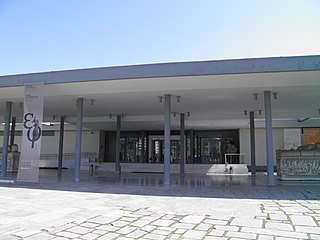
The Archaeological Museum of Thessaloniki is a museum in Thessaloniki, Central Macedonia, Greece. It holds and interprets artifacts from the Prehistoric, Archaic, Classical, Hellenistic and Roman periods, mostly from the city of Thessaloniki but also from the region of Macedonia in general.

Chersonesus is an ancient Greek colony founded approximately 2,500 years ago in the southwestern part of the Crimean Peninsula. Settlers from Heraclea Pontica in Bithynia established the colony in the 6th century BC.

The Treasury of Atreus or Tomb of Agamemnon is a large tholos or beehive tomb constructed between 1400 and 1200 BCE in Mycenae, Greece.
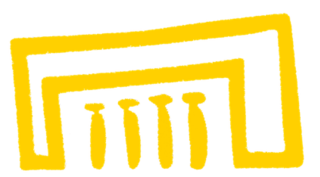
The National Museum of Beirut is the principal museum of archaeology in Lebanon. The collection begun after World War I, and the museum was officially opened in 1942. The museum has collections totaling about 100,000 objects, most of which are antiquities and medieval finds from excavations undertaken by the Directorate General of Antiquities. About 1300 artifacts are exhibited, ranging in date from prehistoric times to the medieval Mamluk period.

The Antalya Museum or Antalya Archeological Museum is one of Turkey's largest museums, located in Konyaaltı, Antalya. It includes 13 exhibition halls and an open air gallery. It covers an area of 7,000 m2 (75,000 sq ft) and 5000 works of art are exhibited. In addition a further 25,000–30,000 artifacts which cannot be displayed are in storage. As a museum exhibiting examples of works, which illuminate the history of the Mediterranean and Pamphylia regions in Anatolia, Antalya Museum is one of the most important of Turkey's museums. The Museum won the “European Council Special Prize” in 1988.

Delphi Archaeological museum is one of the principal museums of Greece and one of the most visited. It is operated by the Greek Ministry of Culture. Founded in 1903, it has been rearranged several times and houses the discoveries made at the Panhellenic sanctuary of Delphi, which date from the Late Helladic (Mycenean) period to the early Byzantine era.

The Museum of Byzantine Culture is a museum in Thessaloniki, Central Macedonia, Greece, which opened in 1994.

The Archaeological Museum of Ancient Corinth was constructed between 1931 and 1932, with intentions to display the numerous recent archaeological excavations. The museum is located within the archaeological site of Ancient Corinth, Greece, and lies under the jurisdiction of the 37th Ephoreia of the Greek Archaeological Service.
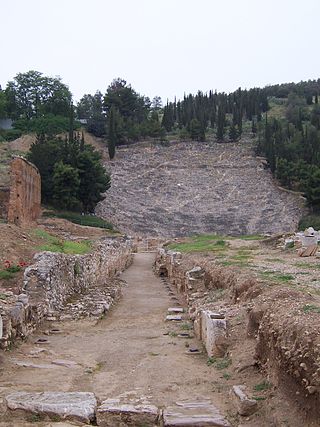
The Archaeological Museum of Argos is a museum in Argos, in Argolis on the Peloponnese peninsula, Greece. The history of the museum began in April 1932, when the heirs of J. Kallergis donated the building to the Argos city council. They in turn gave it to the Greek state along with the surrounding area on October 25, 1955.
The Archaeological Museum of Chios is a museum located on Michalon Street in Chios town, Chios, Greece. It was constructed in 1966-1971 and covers a total area of 2500 square metres. 1200 square metres of floor space is occupied by the exhibitions.

The Archaeological Museum of Dion is a museum in Dion in the Pieria regional unit of Central Macedonia, Greece.

The National Museum of Aleppo is the largest museum in the city of Aleppo, Syria, and was founded in 1931. It is located in the heart of the northern city on Baron Street, adjacent to the famous Baron Hotel and near the Bab al-Faraj Square and Clock Tower. The majority of the museum's exhibitions are devoted to the archaeology of Syria, with most of the finds coming from archaeological sites of the northern part of the country.

Kition was a Ancient Greek city-kingdom on the southern coast of Cyprus. According to the text on the plaque closest to the excavation pit of the Kathari site, it was established in the 13th century BC by Greek (Achaean) settlers, after the Trojan war.
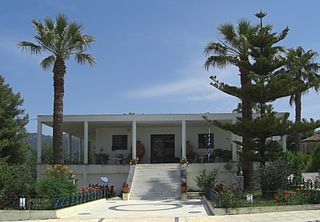
The Archaeological Museum of Chora is a museum in Chora, Messenia, in southern Greece, whose collections focus on the Mycenaean civilization, particularly from the excavations at the Palace of Nestor and other regions of Messenia. The museum was founded in 1969 by the Greek Archaeological Service under the auspices of the Ephorate of Antiquities of Olympia. At the time, the latter included in its jurisdiction the larger part of Messenia.

Aydın Archaeological Museum is in Aydın, western Turkey. Established in 1959, it contains numerous statues, tombs, columns and stone carvings from the Hellenistic, Roman, Byzantine, Seljuk and Ottoman periods, unearthed in ancient cities such as Alinda, Alabanda, Amyzon, Harpasa, Magnesia on the Maeander, Mastaura, Myus, Nisa, Orthosia, Piginda, Pygela and Tralleis. The museum also has a section devoted to ancient coin finds.

Gordion Museum is a museum in Turkey.
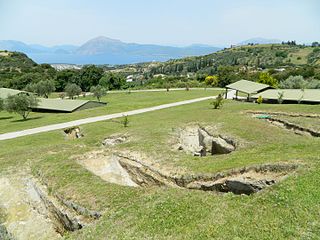
The Mycenaean cemetery of Voudeni along with the Mycenaean settlement at the locality of Bortzi, comprise the Patras Mycenaean Park, located near the settlement of Voudeni of the Municipality of Patras in Western Greece. The archaeological site of a total area of 180 acres is located at an altitude of 220 meters, 7 kilometers northeast of Patras, has been transformed into a recreational park. It includes 78 carved tombs and the ruins of a prehistoric settlement, possibly identified with that of ancient Mesatis. First archaeological excavations began in 1923 by Nikolaos Kyparissis. Many of the findings such as vases, clay statuettes, bronze artifacts, tools, weapons and jewellery have been transported and exhibited at the nearby Archaeological Museum of Patras.




















